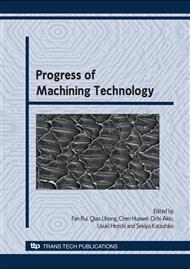p.582
p.589
p.594
p.599
p.604
p.608
p.612
p.619
p.624
Effect of Co Content and WC Grain Size on Wear Resistance of Micro Carbide Endmills in High Speed Milling of Graphite
Abstract:
Micro carbide endmills suffer severe abrasive friction and impact wear in high speed milling of graphite. This paper focused on the study of the effect of Co content and WC grain size on the tool wear resistance of micro carbide endmills in high speed milling of graphite. The tool wear morphologies of cutting tools were examined at the initial wear stage and severe wear stage. The results showed that the abrasive resistance of micro carbide endmill increased with the decrease of Co content and WC grain size. The best impact resistance can be obtained with medium Co content and smaller WC grain size. The fine-grained carbide 0.2WC-8%Co is considered as the optimum tool material for high speed milling of graphite.
Info:
Periodical:
Pages:
604-607
Citation:
Online since:
February 2009
Authors:
Keywords:
Price:
Сopyright:
© 2009 Trans Tech Publications Ltd. All Rights Reserved
Share:
Citation:


